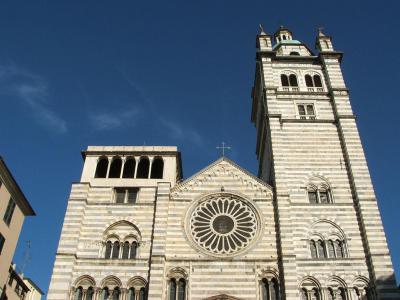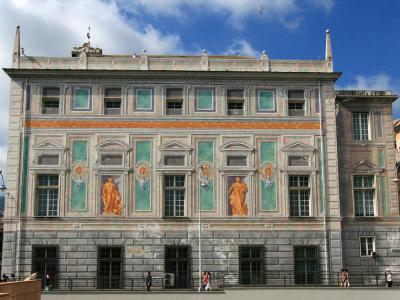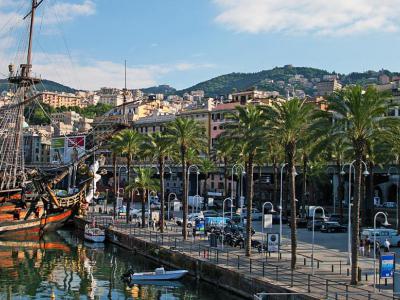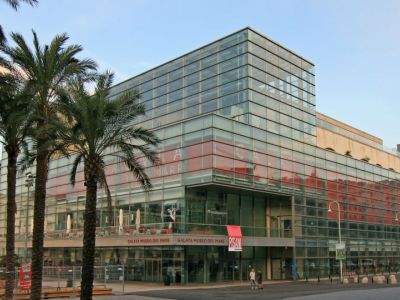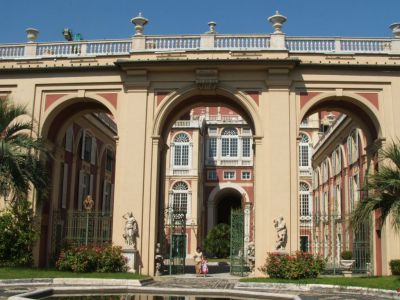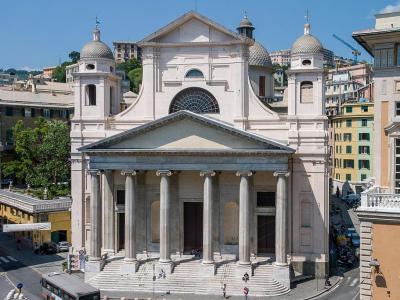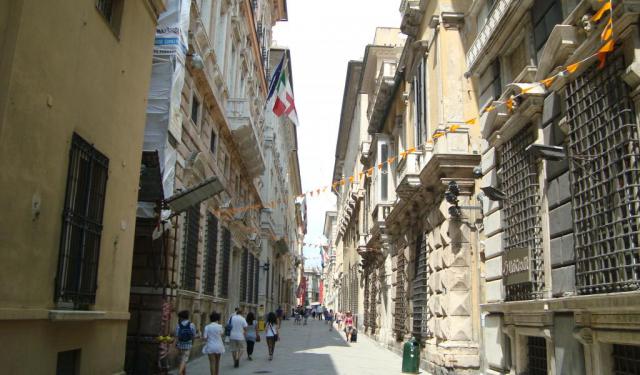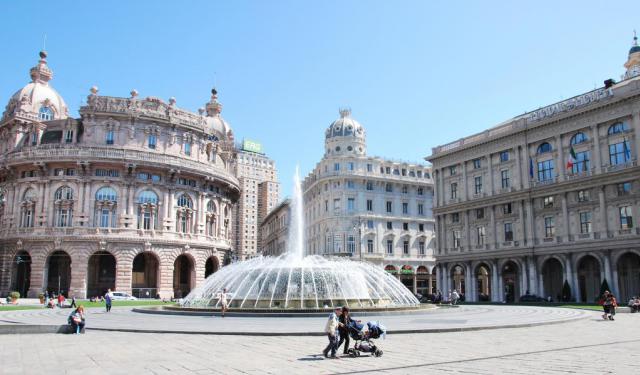
Genoa Introduction Walking Tour (Self Guided), Genoa
Petrarch, an Italian poet of the early Renaissance known as the "father of humanism," called Genoa "La Superba" (The Proud One). Genoa is deservedly proud of her maritime glory and unique architecture.
From the 11th century until the late 18th century, the city became a leading economic and military power in Europe. It was one of the wealthiest cities in the world through its maritime trade and commerce.
What to do with all this wealth? In the late 16th century, the Genoese aristocracy implemented a plan to transform the medieval city. A "New Streets" system was created to provide space for their sumptuous private palaces and mansions.
In 1576 the Genoese Senate established a list of forty-two palaces that could be used as hospitality residences for notable guests from abroad, such as kings, princes, diplomats, or religious authorities. The list was updated over the years. These lists were called "rolli," literally, "rolls."
All told, 162 palaces made the lists at least once. These palaces became a World Heritage Site in 2006. The most prestigious buildings are located on the New Streets including Lomellini Street, Garibaldi Street, and Balbi Street.
The Genoese nobility once considered the whole city a "Republican Royal Palace." A walk on the New Streets is a must-do for any trip to Genoa.
Also visit the Gothic-Romanesque Saint Lawrence Cathedral, inaugurated in 1118. The Church of Jesus and Saints Ambrose and Andrew, the Basilica of the Most Holy Annunciation, the Basilica of Saint Mary of Castello, and many other churches dating through the Middle Ages and the Renaissance are treasure houses of art and tradition.
Genoa has reinvigorated its harbor. Today the Old Port is a visitor-friendly museum and amusement area. It has an aquarium, a marina, cafes, and restaurants. The Galata Museum of the Sea traces the voyage of Genoa through the ages of discovery into the modern era.
Petrarch was right.
From the 11th century until the late 18th century, the city became a leading economic and military power in Europe. It was one of the wealthiest cities in the world through its maritime trade and commerce.
What to do with all this wealth? In the late 16th century, the Genoese aristocracy implemented a plan to transform the medieval city. A "New Streets" system was created to provide space for their sumptuous private palaces and mansions.
In 1576 the Genoese Senate established a list of forty-two palaces that could be used as hospitality residences for notable guests from abroad, such as kings, princes, diplomats, or religious authorities. The list was updated over the years. These lists were called "rolli," literally, "rolls."
All told, 162 palaces made the lists at least once. These palaces became a World Heritage Site in 2006. The most prestigious buildings are located on the New Streets including Lomellini Street, Garibaldi Street, and Balbi Street.
The Genoese nobility once considered the whole city a "Republican Royal Palace." A walk on the New Streets is a must-do for any trip to Genoa.
Also visit the Gothic-Romanesque Saint Lawrence Cathedral, inaugurated in 1118. The Church of Jesus and Saints Ambrose and Andrew, the Basilica of the Most Holy Annunciation, the Basilica of Saint Mary of Castello, and many other churches dating through the Middle Ages and the Renaissance are treasure houses of art and tradition.
Genoa has reinvigorated its harbor. Today the Old Port is a visitor-friendly museum and amusement area. It has an aquarium, a marina, cafes, and restaurants. The Galata Museum of the Sea traces the voyage of Genoa through the ages of discovery into the modern era.
Petrarch was right.
How it works: Download the app "GPSmyCity: Walks in 1K+ Cities" from Apple App Store or Google Play Store to your mobile phone or tablet. The app turns your mobile device into a personal tour guide and its built-in GPS navigation functions guide you from one tour stop to next. The app works offline, so no data plan is needed when traveling abroad.
Genoa Introduction Walking Tour Map
Guide Name: Genoa Introduction Walking Tour
Guide Location: Italy » Genoa (See other walking tours in Genoa)
Guide Type: Self-guided Walking Tour (Sightseeing)
# of Attractions: 13
Tour Duration: 2 Hour(s)
Travel Distance: 3.8 Km or 2.4 Miles
Author: ChristineCu
Sight(s) Featured in This Guide:
Guide Location: Italy » Genoa (See other walking tours in Genoa)
Guide Type: Self-guided Walking Tour (Sightseeing)
# of Attractions: 13
Tour Duration: 2 Hour(s)
Travel Distance: 3.8 Km or 2.4 Miles
Author: ChristineCu
Sight(s) Featured in This Guide:
- Piazza De Ferrari (Ferrari Square)
- Church of Jesus and Saints Ambrose and Andrew
- Palazzo Ducale (Doge's Palace)
- Cattedrale di San Lorenzo ( Cathedral of St. Lawrence)
- Palazzo San Giorgio (Palace of St. George)
- Porto Antico di Genova (Genoa Old Port)
- Galata Museo del Mare (Galata Maritime Museum)
- Palazzo Reale (Royal Palace Museum)
- Basilica of the Santissima Annunziata del Vastato
- Spianata di Castelletto (Esplanade of Castelletto)
- Palazzo Bianco (White Palace)
- Via Giuseppe Garibaldi (Giuseppe Garibaldi Street)
- Via XX Settembre (20th September Street)
1) Piazza De Ferrari (Ferrari Square) (must see)
Raffaele Luigi De Ferrari, Prince of Lucedio, Duke of Galliera, and senator of the Kingdom of Sardina, in 1837, acquired via Prince Oscar of Sweden all possessions that Napoleon I had granted in 1812. He was abundantly rich, Grand Officer of the Order of Italy. These are not all his honors, but enough to have the main square of Genoa named after him.
The Ferrari Square covers an area of 120,000 square feet. In the center of the square is a gigantic bronze fountain built in 1936 and designed by architect Giuseppe Crosa di Vergagni.
In 1814 The Church of San Domenico was demolished to build the Carlo Felice Theater, designed by Carlo Barabino and completed in 1827.
In 1831 the two-story Linguistic Academy took its place by the square. The square was christened Ferrari Square in 1877, one year after his passing. In 1893 Giuseppe Garibaldi, a hero of the Italian revolution appeared astride his bronze horse in front of the Carlo Felice Theater.
Four large buildings showing eclectic architectural styles appeared; New Stock Exchange Palace (Palazzo della Nuova Borsa) in 1912; the Palace of the Italian Credit (Palazzo del Credito Italiano) in 1914; and the Palace of the Liguria Region (Palazzo della Regione Liguria) in 1923.
Older buildings include the Ducal Palace, built in the 13th century and restored in 1992; it is currently a museum and palace of culture; Giulio Pallavicini Palace, built in 1586; and Agostino Spinola Palace, built in the 18th century, now Bank of Rome.
The Ferrari Square covers an area of 120,000 square feet. In the center of the square is a gigantic bronze fountain built in 1936 and designed by architect Giuseppe Crosa di Vergagni.
In 1814 The Church of San Domenico was demolished to build the Carlo Felice Theater, designed by Carlo Barabino and completed in 1827.
In 1831 the two-story Linguistic Academy took its place by the square. The square was christened Ferrari Square in 1877, one year after his passing. In 1893 Giuseppe Garibaldi, a hero of the Italian revolution appeared astride his bronze horse in front of the Carlo Felice Theater.
Four large buildings showing eclectic architectural styles appeared; New Stock Exchange Palace (Palazzo della Nuova Borsa) in 1912; the Palace of the Italian Credit (Palazzo del Credito Italiano) in 1914; and the Palace of the Liguria Region (Palazzo della Regione Liguria) in 1923.
Older buildings include the Ducal Palace, built in the 13th century and restored in 1992; it is currently a museum and palace of culture; Giulio Pallavicini Palace, built in 1586; and Agostino Spinola Palace, built in the 18th century, now Bank of Rome.
2) Church of Jesus and Saints Ambrose and Andrew
In the 6th century, Bishop Onorato of Milan was on the run. He was escaping from Longobard persecutions to Genoa. There he founded his Church of Saint Ambrose. Ambrose is Milan's patron Saint. Abandoned in the 7th century by the Milanese community, the church was taken over in the 16th century by the Jesuits.
In 1522 the Jesuits rebuilt the old church based on the designs of architect Giuseppe Valeriano. The façade was changed, following Rubens's designs, in the late 19th century. It was now Baroque and included statues of Sant Ambrogio and Sant Andrea by Michele Ramognino.
There are frescoes by Giovanni Battista Carlone in the nave and dome. On the main altar are the following paintings: the Circumcision by Peter Rubens, the Massacre of the Innocents by Giovanni Battista Merano, and the Flight into Egypt by Domenico Piola. There are statues of Peter and Paul by Giuseppe Carlone.
In the first chapel is a fresco by Giuseppe Galeotti and a painting by Giovanni Andrea De Ferrari. The niches hold statues of Saint Carlo Borlomeo and Sant Ambrogio by Giovanni Domenico Casella.
In the second chapel is a fresco by Lorenzo De Ferrari and the Crucifixion, a painting by Simon Vouet. Beside the altar is a nativity scene by Tommaso Orsolino.
In the third chapel are frescoes by Lorenzo De Ferrari and a painting of the Assumption by Guido Reni.
In 1522 the Jesuits rebuilt the old church based on the designs of architect Giuseppe Valeriano. The façade was changed, following Rubens's designs, in the late 19th century. It was now Baroque and included statues of Sant Ambrogio and Sant Andrea by Michele Ramognino.
There are frescoes by Giovanni Battista Carlone in the nave and dome. On the main altar are the following paintings: the Circumcision by Peter Rubens, the Massacre of the Innocents by Giovanni Battista Merano, and the Flight into Egypt by Domenico Piola. There are statues of Peter and Paul by Giuseppe Carlone.
In the first chapel is a fresco by Giuseppe Galeotti and a painting by Giovanni Andrea De Ferrari. The niches hold statues of Saint Carlo Borlomeo and Sant Ambrogio by Giovanni Domenico Casella.
In the second chapel is a fresco by Lorenzo De Ferrari and the Crucifixion, a painting by Simon Vouet. Beside the altar is a nativity scene by Tommaso Orsolino.
In the third chapel are frescoes by Lorenzo De Ferrari and a painting of the Assumption by Guido Reni.
3) Palazzo Ducale (Doge's Palace) (must see)
The Duke's Palace was once home to the Doges of Genoa. This historical building, in the heart of the city, is accessible from both Matteotti Square and Ferrari Square. It was constructed in the 13th century when Genoa was coming into its own as a maritime power.
In Genoa, the head of state was called the Captain of the People. The Captain and staff were practically homeless and spent most of their time in either the Archbishop's Palace or the homes of the Doria and Fieschi families.
That all changed by 1294. Co-Captain of the People, Corrado Doria, and Oberto Spinola had bought the Doria family buildings and the mansion of Alberto Fieschi. These buildings merged and became the abbots' palaces.
In 1339, Simone Boccanegra ("Simon Blackmouth") was the first doge of Genoa. The palace was named "Duke." In the 14th century, new buildings were added to the complex. By the 15th century, a garrison building was added, and the square became a fortified courtyard.
The Doge's Palace was reconstructed in the 18th century after a devastating fire. The architect Simone Cantoni created a new facade of marble and redesigned the public rooms in gilded stucco and marble.
Today this elder center of power is used for exhibitions, meetings, special events, and as a library and museum. It is the result of the largest restoration in Europe, covering a building of 300,000 square meters.
In Genoa, the head of state was called the Captain of the People. The Captain and staff were practically homeless and spent most of their time in either the Archbishop's Palace or the homes of the Doria and Fieschi families.
That all changed by 1294. Co-Captain of the People, Corrado Doria, and Oberto Spinola had bought the Doria family buildings and the mansion of Alberto Fieschi. These buildings merged and became the abbots' palaces.
In 1339, Simone Boccanegra ("Simon Blackmouth") was the first doge of Genoa. The palace was named "Duke." In the 14th century, new buildings were added to the complex. By the 15th century, a garrison building was added, and the square became a fortified courtyard.
The Doge's Palace was reconstructed in the 18th century after a devastating fire. The architect Simone Cantoni created a new facade of marble and redesigned the public rooms in gilded stucco and marble.
Today this elder center of power is used for exhibitions, meetings, special events, and as a library and museum. It is the result of the largest restoration in Europe, covering a building of 300,000 square meters.
Sight description based on Wikipedia.
4) Cattedrale di San Lorenzo ( Cathedral of St. Lawrence) (must see)
The Cathedral of San Lorenzo is the most dominant church in Genoa. The religious edifice was built around 1098 and inaugurated by Pope Gelasius II in 1118. With the construction of the walls, the area around San Lorenzo became the city's heart. During medieval times, the church was the center stage of social and political life for the residents of Genoa.
After a disastrous fire in 1296, the church was rebuilt. The facade was completed in 1312. The colonnades were restored, and matron galleries were added. The construction of the cathedral finished in the 17th century. The dome and medieval portions were restored between 1894-1900.
The main facade of the cathedral has three Gothic portals with recessed arches. The lunette above the central portal has reliefs depicting Christ with Saint Lawrence. A large rose window is above the center portal. Two stone lions and two short columns flank the front stairs. Two towers of unequal height grace the front facade.
The interior has a basilica plan with a transept and choir. Three naves are divided by marble columns topped by arches with light and dark bands. Above these are smaller Romanesque arches of grey stone.
The left side chapel is dedicated to Saint John the Baptist, patron saint of Genoa. The chapel houses an urn with relics of the saint brought here at the end of the First Crusade.
On February 9, 1941, the Cathedral of Saint Lawrence was shot by the English battleship HMS Malaya. An armor-piercing shell penetrated a corner of the nave. The relatively soft material failed to detonate the fuse, and the shell is still there. Look for this curiosity piece when you visit the cathedral.
There is no fee to visit the cathedral, but admission is charged for a visit to its treasure museum.
After a disastrous fire in 1296, the church was rebuilt. The facade was completed in 1312. The colonnades were restored, and matron galleries were added. The construction of the cathedral finished in the 17th century. The dome and medieval portions were restored between 1894-1900.
The main facade of the cathedral has three Gothic portals with recessed arches. The lunette above the central portal has reliefs depicting Christ with Saint Lawrence. A large rose window is above the center portal. Two stone lions and two short columns flank the front stairs. Two towers of unequal height grace the front facade.
The interior has a basilica plan with a transept and choir. Three naves are divided by marble columns topped by arches with light and dark bands. Above these are smaller Romanesque arches of grey stone.
The left side chapel is dedicated to Saint John the Baptist, patron saint of Genoa. The chapel houses an urn with relics of the saint brought here at the end of the First Crusade.
On February 9, 1941, the Cathedral of Saint Lawrence was shot by the English battleship HMS Malaya. An armor-piercing shell penetrated a corner of the nave. The relatively soft material failed to detonate the fuse, and the shell is still there. Look for this curiosity piece when you visit the cathedral.
There is no fee to visit the cathedral, but admission is charged for a visit to its treasure museum.
5) Palazzo San Giorgio (Palace of St. George)
The Byzantine Emperor Michael VIII felt indebted to Genoa. Genoa had been his ally in a war against the Latin Empire. To show his appreciation, Emperor Michael donated material stripped from the Venetian embassy in Constantinople to Guglielmo Boccanegra. Boccanegra used the material to build his waterfront dream palace. The year was 1260.
Stone lions, the emblem of Venice's patron, Saint Mark, soon decorated the facade of Guglielmo's grand palace. But two years later, Boccanegra was deposed as Captain of the People and forced into exile. The building became a prison. Marco Polo was the most famous prisoner. He dictated his memoirs to Rustichello of Pisa, a romance writer best known for co-writing Marco Polo's autobiography, The Travels of Marco Polo, while they were in prison together.
The palace, among other things, was intended to be the headquarters for port authorities. Design was by Frate Oliverio, a Cistercian monk. In 1400 the building became the home of the Bank of San Giorgio, one of Italy's first banks.
In 1570 an East wing was added to hold customs offices, archives, and bank vaults. In 1608 the main facade was painted with heroic frescos, the center fresco featuring Saint George and the dragon. A clock tower was erected on the roof over the facade's center.
On the facade are niches holding statues of heroic figures of Genoa's past. They are Christopher Columbus, Andrea Doria, Biagio Assereto, Simone Boccanegra, Guglielmo Embriaco, and Caffaro di Rustico. Presently the Palace of St. George is the administrative center of the Port.
Stone lions, the emblem of Venice's patron, Saint Mark, soon decorated the facade of Guglielmo's grand palace. But two years later, Boccanegra was deposed as Captain of the People and forced into exile. The building became a prison. Marco Polo was the most famous prisoner. He dictated his memoirs to Rustichello of Pisa, a romance writer best known for co-writing Marco Polo's autobiography, The Travels of Marco Polo, while they were in prison together.
The palace, among other things, was intended to be the headquarters for port authorities. Design was by Frate Oliverio, a Cistercian monk. In 1400 the building became the home of the Bank of San Giorgio, one of Italy's first banks.
In 1570 an East wing was added to hold customs offices, archives, and bank vaults. In 1608 the main facade was painted with heroic frescos, the center fresco featuring Saint George and the dragon. A clock tower was erected on the roof over the facade's center.
On the facade are niches holding statues of heroic figures of Genoa's past. They are Christopher Columbus, Andrea Doria, Biagio Assereto, Simone Boccanegra, Guglielmo Embriaco, and Caffaro di Rustico. Presently the Palace of St. George is the administrative center of the Port.
6) Porto Antico di Genova (Genoa Old Port) (must see)
Genoa Old Port brings back Genoa's golden age as a principal sea-faring city and maritime power. The Old Port does all this with a tourist-friendly approach. Old galleons, sleek modern yachts, and mighty cruise ships are in the harbor.
There are restaurants, museums, an aquarium, an auditorium, a botanical garden in a bubble, and a gigantic octopus crane used to his visitors aloft for a better view of the Genoa Old Port. The port is ideal for a walk in the sunset with a panorama of the sea without leaving the city. It is also ok for a moonlight stroll.
The project was carried out following the designs and ideas of Renzo Piano, a world-famous architect and native of Genoa. His goal was to change the dilapidated industrial area of the old port into a cultural center and tourist mecca.
The International Exhibition Genoa '92 - Colombo '92 was held from May to August. The theme was "Christopher Columbus, the Ship, and the Sea." It was the 500th anniversary of the voyage of Columbus to the New World and the debut of the restored Genoa Old Port.
There are restaurants, museums, an aquarium, an auditorium, a botanical garden in a bubble, and a gigantic octopus crane used to his visitors aloft for a better view of the Genoa Old Port. The port is ideal for a walk in the sunset with a panorama of the sea without leaving the city. It is also ok for a moonlight stroll.
The project was carried out following the designs and ideas of Renzo Piano, a world-famous architect and native of Genoa. His goal was to change the dilapidated industrial area of the old port into a cultural center and tourist mecca.
The International Exhibition Genoa '92 - Colombo '92 was held from May to August. The theme was "Christopher Columbus, the Ship, and the Sea." It was the 500th anniversary of the voyage of Columbus to the New World and the debut of the restored Genoa Old Port.
7) Galata Museo del Mare (Galata Maritime Museum) (must see)
Galata refers to the historic Genoese community of Istanbul, Turkey. It was one of the most vital Genoese colonies in the Mediterranean. In the 15th century, their presence in that community ended. In the 19th century, the Genoa municipality built a system of commercial docks. The oldest was named for the lost colony.
Galata was a thriving shipyard where the Genoese galleys were built. In the 20th century, the maritime position of Genoa changed, and the district was abandoned. In the 1990s, it was decided to create a marine museum in the Galata district. The Galata Palace, renovated by architect Guillermo Consuegra, houses the museum.
The museum opened in 2004. In 2005 it was merged with the Commenda Museum-Theater and the Naval Museum of Pegli, becoming the Institute of Museums of the Sea and Migration.
The ground floor of the museum tells the story of galleys. It has a full-scale model of a 17th-century galley and an exhibit of armor and weapons. There are also portraits of Columbus and Andrea Doria, documents, charts, and navigation paraphernalia.
The first and second floors are given to sailing and shipyards. There is a reproduction of a Brigantine, a shipyard workshop, and a virtual storm off Cape Horn. The third floor is dedicated to the great Transatlantic liners. It features a mockup of a ship's bridge and a simulation of an immigrant's voyage from Gibraltar to New York.
The submarine Nazario Sauro (S 518) is moored at the museum's dock as a floating annex.
Galata was a thriving shipyard where the Genoese galleys were built. In the 20th century, the maritime position of Genoa changed, and the district was abandoned. In the 1990s, it was decided to create a marine museum in the Galata district. The Galata Palace, renovated by architect Guillermo Consuegra, houses the museum.
The museum opened in 2004. In 2005 it was merged with the Commenda Museum-Theater and the Naval Museum of Pegli, becoming the Institute of Museums of the Sea and Migration.
The ground floor of the museum tells the story of galleys. It has a full-scale model of a 17th-century galley and an exhibit of armor and weapons. There are also portraits of Columbus and Andrea Doria, documents, charts, and navigation paraphernalia.
The first and second floors are given to sailing and shipyards. There is a reproduction of a Brigantine, a shipyard workshop, and a virtual storm off Cape Horn. The third floor is dedicated to the great Transatlantic liners. It features a mockup of a ship's bridge and a simulation of an immigrant's voyage from Gibraltar to New York.
The submarine Nazario Sauro (S 518) is moored at the museum's dock as a floating annex.
8) Palazzo Reale (Royal Palace Museum) (must see)
The Balbi family found fortune in the trade of silks and finance. In the 17th century, they built their dream palace, which is now on the list of World Heritage Sites.
Stefano and Giovanni Battista Balbi died in the plague of 1657. The palace was sold to the Durazzo family. The Durazzos had fled from Albania, ultimately becoming successful merchants in Genoa.
In 1823, the Royal Savoia family acquired the palace. King Carlo Felice di Savoie used it as a summer residence. Since 1919, the building has belonged to the state.
The palace is now home to Liguria's Department for Artistic, Historical, and Archeological Heritage and the Royal Palace Museum. The interior style of each room is unique.
The Battle Room has paintings of naval battles of the 18th century. The Hall of Time has 23 artworks by Tintoretto and Bassano. The Hall of the Veronese has a 17th-century copy of The Supper of Christ in the House of Simon the Pharisee.
The Hall of Mirrors is an interpretation of the Versailles Ice Gallery. It was created by Domenico Parodi for Girolamo II Durazzo. It was used as a dining room to entertain Emperor Joseph II of Austria and Napoleon Bonaparte.
The Chapel Gallery is for the Passion of Christ. It has a painting of Christ at the Column by Filippo Parodi.
Stefano and Giovanni Battista Balbi died in the plague of 1657. The palace was sold to the Durazzo family. The Durazzos had fled from Albania, ultimately becoming successful merchants in Genoa.
In 1823, the Royal Savoia family acquired the palace. King Carlo Felice di Savoie used it as a summer residence. Since 1919, the building has belonged to the state.
The palace is now home to Liguria's Department for Artistic, Historical, and Archeological Heritage and the Royal Palace Museum. The interior style of each room is unique.
The Battle Room has paintings of naval battles of the 18th century. The Hall of Time has 23 artworks by Tintoretto and Bassano. The Hall of the Veronese has a 17th-century copy of The Supper of Christ in the House of Simon the Pharisee.
The Hall of Mirrors is an interpretation of the Versailles Ice Gallery. It was created by Domenico Parodi for Girolamo II Durazzo. It was used as a dining room to entertain Emperor Joseph II of Austria and Napoleon Bonaparte.
The Chapel Gallery is for the Passion of Christ. It has a painting of Christ at the Column by Filippo Parodi.
9) Basilica of the Santissima Annunziata del Vastato
The word "vastato" derives from the Latin word "vastinium." It means a belt of land outside the walls razed for defensive purposes. The Basilica of the Santissima Annunziata del Vastato was built outside the city walls. Construction began by the Franciscans in 1520 on the previous site of the Church of Santa Maria del Prato.
Work was interrupted in 1537 and not resumed until 1591, when the Lomellini family continued the construction conducted by architect Taddeo Carlone. In the 17th century, Baroque decorations were added under the direction of painter Andrea Ansaldo. The present Neoclassicist facade, designed by Carlo Barabino, was added between 1830 and 1840.
The basilica is fronted with a Latin portico with a triangular roof supported by six ionic stone columns and two pilasters. Above the porch on the facade are two lunette windows, the smaller window above the larger one. Two bell towers flank the building's facade.
The church is laid out in a Latin cross and divided into three naves with two rows of lateral altars. The naves are separated by Corinthian columns with arches. The interior is like a 17th-century gallery of art. It is lavishly decorated with inlaid marble, gilded stucco, and frescoes by 23 local artists and 13 sculptors.
Work was interrupted in 1537 and not resumed until 1591, when the Lomellini family continued the construction conducted by architect Taddeo Carlone. In the 17th century, Baroque decorations were added under the direction of painter Andrea Ansaldo. The present Neoclassicist facade, designed by Carlo Barabino, was added between 1830 and 1840.
The basilica is fronted with a Latin portico with a triangular roof supported by six ionic stone columns and two pilasters. Above the porch on the facade are two lunette windows, the smaller window above the larger one. Two bell towers flank the building's facade.
The church is laid out in a Latin cross and divided into three naves with two rows of lateral altars. The naves are separated by Corinthian columns with arches. The interior is like a 17th-century gallery of art. It is lavishly decorated with inlaid marble, gilded stucco, and frescoes by 23 local artists and 13 sculptors.
10) Spianata di Castelletto (Esplanade of Castelletto) (must see)
The term "Castelletto" means "little castle." It generally refers to a neighborhood, not a mini fortress. There was a small fortress overlooking Genoa proper. It was built in the 10th century and torn down in the 19th century to clear room for residential buildings.
When the Castelletto was demolished, it left behind the Belvedere Montaldo, a vantage point 240 feet high offering great views of Genoa proper. The best way to reach the Belvedere is the public lift in Portale Square, described as the best route to heaven by the poet Giorgio Caproni. The lift terminus is a beautiful art nouveau tower.
It is not widely known that the city's old reservoirs, which collected water from the ancient aqueduct over the Bisagno Valley, are located under the ruin of the Castelletto.
The Esplanade of Castelletto neighborhood is in the hills above the city. It is a real neighborhood, ideal for afternoon or evening explorations. It is easily reached from the city center.
When the Castelletto was demolished, it left behind the Belvedere Montaldo, a vantage point 240 feet high offering great views of Genoa proper. The best way to reach the Belvedere is the public lift in Portale Square, described as the best route to heaven by the poet Giorgio Caproni. The lift terminus is a beautiful art nouveau tower.
It is not widely known that the city's old reservoirs, which collected water from the ancient aqueduct over the Bisagno Valley, are located under the ruin of the Castelletto.
The Esplanade of Castelletto neighborhood is in the hills above the city. It is a real neighborhood, ideal for afternoon or evening explorations. It is easily reached from the city center.
11) Palazzo Bianco (White Palace)
The White Palace got its name for the plain color of its facade. It was built between 1530 and 1540 by troubadour, politician, and diplomat Luca Grimaldi. Grimaldi was a prominent Genoese family. In 1658 the building became the property of the De Franchi Toso family. In 1711 Federico de Franchi Toso ceded the palace to Maria Durazzo Brignole-Sale to pay off a debt.
From 1714 to 1716, the Durazzos made extensive restorations. It was at this time the palace got its "White" name. In 1899 Maria Brignole-Sale, the last member of the Durazzos family, ceded the property to the municipality to be used as a public gallery. She dedicated the gallery in 1884 to enlarge its collection.
La Donna Maria's penchant for Spanish and Flemish painters stands out. Van Dyck, Rubens, Filippino Lippi, Veronese, and Caravaggio are all represented. The real jewel of the museum is Lucas Cranach the Elder's "Portrait of a Lady." On the upper floors is a captivating collection of 19th and 20th-century fashions.
The White Palace is located on Garibaldi street within the New Street UNESCO World Heritage site. It is easily reached on foot from the city center.
From 1714 to 1716, the Durazzos made extensive restorations. It was at this time the palace got its "White" name. In 1899 Maria Brignole-Sale, the last member of the Durazzos family, ceded the property to the municipality to be used as a public gallery. She dedicated the gallery in 1884 to enlarge its collection.
La Donna Maria's penchant for Spanish and Flemish painters stands out. Van Dyck, Rubens, Filippino Lippi, Veronese, and Caravaggio are all represented. The real jewel of the museum is Lucas Cranach the Elder's "Portrait of a Lady." On the upper floors is a captivating collection of 19th and 20th-century fashions.
The White Palace is located on Garibaldi street within the New Street UNESCO World Heritage site. It is easily reached on foot from the city center.
12) Via Giuseppe Garibaldi (Giuseppe Garibaldi Street) (must see)
Giuseppe Garibaldi Street is one of the "New Streets" built by Genoese aristocrats in the Renaissance period. The street was built in 1583, and its original name was Major Street (Strada Maggiore ) or New Street (Strada Nuova). It was renamed Giuseppe Garibaldi in 1882. It is 956 feet long and 25 feet wide.
In the 16th and 17th centuries, the oligarchs of Genoa planned to change their medieval city and expand to the northern areas. Genoa had never been richer. More than enough funds were available, and the urban expansion ambitions could be realized. The nobility and wealth contemplated a growing city of palaces and splendid exurban villas.
From New Street and Major Street, the street name morphed into Golden Street (Strada Aurea). It changed names for the final time, as noted, in 1882. On Garibaldi Street, the New Street Museum complex joins the three palaces: Doria Tursi Palace (Seat of the Town Hall), White Palace, and Podesta Palace.
In the days of the Republic, the city kept Rolli, lists of the most attractive homes and palaces of the noble families who would perform the duty of hosts for important state visits. According to the rank of a visitor, a palace would be chosen for hosting. The more notable guests would get the richest, most opulent lodging.
Twice a year, in spring and autumn, Genoa has Rolli Days. On Rolli Day weekends, the beautiful buildings on Giuseppe Garibaldi street open their doors to the public.
Charles Dickens in his "Pictures from Italy" wrote: "...When shall I forget the Streets of Palaces: the Strada Nuova and the Strada Balbi!...again, and again, and again,...every palace is succeeded by another..." Another surprising part of Genoa.
In the 16th and 17th centuries, the oligarchs of Genoa planned to change their medieval city and expand to the northern areas. Genoa had never been richer. More than enough funds were available, and the urban expansion ambitions could be realized. The nobility and wealth contemplated a growing city of palaces and splendid exurban villas.
From New Street and Major Street, the street name morphed into Golden Street (Strada Aurea). It changed names for the final time, as noted, in 1882. On Garibaldi Street, the New Street Museum complex joins the three palaces: Doria Tursi Palace (Seat of the Town Hall), White Palace, and Podesta Palace.
In the days of the Republic, the city kept Rolli, lists of the most attractive homes and palaces of the noble families who would perform the duty of hosts for important state visits. According to the rank of a visitor, a palace would be chosen for hosting. The more notable guests would get the richest, most opulent lodging.
Twice a year, in spring and autumn, Genoa has Rolli Days. On Rolli Day weekends, the beautiful buildings on Giuseppe Garibaldi street open their doors to the public.
Charles Dickens in his "Pictures from Italy" wrote: "...When shall I forget the Streets of Palaces: the Strada Nuova and the Strada Balbi!...again, and again, and again,...every palace is succeeded by another..." Another surprising part of Genoa.
13) Via XX Settembre (20th September Street)
Commonly called the "Street Twenty" (Via Venti), there are many Via XXs around Italy, and with good reason. It is named for the 20th of September 1870, the day revolutionaries stormed the Pia Gate (Porta Pia) of the Vatican. It marked the end of the temporal power of the Church, the "Risorgimento," which ushered in the unification of Italy.
20th September Street of Genoa was formerly Giulia Street. It was redesigned and modernized from 1892 to 1912. There was a lot of resistance to modernization. Some buildings would have to be demolished. Appeals from building owners and churches had stalled progress.
The street was built on the old route of Giulia Street, which was extended from Ferrari Square to the Monumental Bridge and the Street of Consolation (Via della Consolazione) to Pila Gate (Porta Pila).
The Monumental Bridge crosses 20th September Street longitudinally in the middle. The bridge is supported by marble arches. Its function is to connect two road systems. The lower one is 20th September Street. The upper one is Andrea Podesta Course (Corso Andrea Podesta).
It is a ten to fifteen-minute walk from Ferrari Square to Vittoria Square. 20th September Street is the go-to place for shopping in Genoa. Buses from every part of town pass on this street, dropping off shoppers and picking them up. The street is lined with shops of all kinds and majestic-looking buildings.
The street has a lot of Art Nouveau decorations, smooth pavements, and fabulous architecture and colonnades offering protection from the weather. There are about three miles of shops, usually high-end chain stores. It might be a good idea to pedestrianize a major shopping street, but 20th September Street is the main artery across the city.
20th September Street of Genoa was formerly Giulia Street. It was redesigned and modernized from 1892 to 1912. There was a lot of resistance to modernization. Some buildings would have to be demolished. Appeals from building owners and churches had stalled progress.
The street was built on the old route of Giulia Street, which was extended from Ferrari Square to the Monumental Bridge and the Street of Consolation (Via della Consolazione) to Pila Gate (Porta Pila).
The Monumental Bridge crosses 20th September Street longitudinally in the middle. The bridge is supported by marble arches. Its function is to connect two road systems. The lower one is 20th September Street. The upper one is Andrea Podesta Course (Corso Andrea Podesta).
It is a ten to fifteen-minute walk from Ferrari Square to Vittoria Square. 20th September Street is the go-to place for shopping in Genoa. Buses from every part of town pass on this street, dropping off shoppers and picking them up. The street is lined with shops of all kinds and majestic-looking buildings.
The street has a lot of Art Nouveau decorations, smooth pavements, and fabulous architecture and colonnades offering protection from the weather. There are about three miles of shops, usually high-end chain stores. It might be a good idea to pedestrianize a major shopping street, but 20th September Street is the main artery across the city.
Walking Tours in Genoa, Italy
Create Your Own Walk in Genoa
Creating your own self-guided walk in Genoa is easy and fun. Choose the city attractions that you want to see and a walk route map will be created just for you. You can even set your hotel as the start point of the walk.
Rolli Palaces Walking Tour
The Rolli di Genova – or, more precisely, the Rolli degli alloggiamenti pubblici di Genova (Italian for "Lists of the public lodgings of Genoa") – were first established in the Republic of Genoa in 1576. Originally, these official lists included private palaces and mansions belonging to the most distinguished local families, which - if chosen through a public lottery - were obliged... view more
Tour Duration: 1 Hour(s)
Travel Distance: 0.4 Km or 0.2 Miles
Tour Duration: 1 Hour(s)
Travel Distance: 0.4 Km or 0.2 Miles
The Most Popular Cities
/ view all



